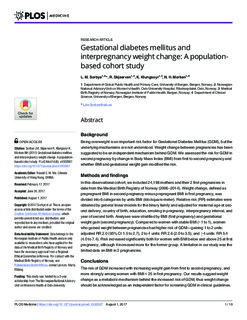| dc.description.abstract | Background Being overweight is an important risk factor for Gestational Diabetes Mellitus (GDM), but the underlying mechanisms are not understood. Weight change between pregnancies has been suggested to be an independent mechanism behind GDM. We assessed the risk for GDM in second pregnancy by change in Body Mass Index (BMI) from first to second pregnancy and whether BMI and gestational weight gain modified the risk. Methods and findings In this observational cohort, we included 24,198 mothers and their 2 first pregnancies in data from the Medical Birth Registry of Norway (2006-2014). Weight change, defined as prepregnant BMI in second pregnancy minus prepregnant BMI in first pregnancy, was divided into 6 categories by units BMI (kilo/square meter). Relative risk (RR) estimates were obtained by general linear models for the binary family and adjusted for maternal age at second delivery, country of birth, education, smoking in pregnancy, interpregnancy interval, and year of second birth. Analyses were stratified by BMI (first pregnancy) and gestational weight gain (second pregnancy). Compared to women with stable BMI (-1 to 1), women who gained weight between pregnancies had higher risk of GDM-gaining 1 to 2 units: adjusted RR 2.0 (95% CI 1.5 to 2.7), 2 to 4 units: RR 2.6 (2.0 to 3.5), and >= 4 units: RR 5.4 (4.0 to 7.4). Risk increased significantly both for women with BMI below and above 25 at first pregnancy, although it increased more for the former group. A limitation in our study was the limited data on BMI in 2 pregnancies. Conclusions The risk of GDM increased with increasing weight gain from first to second pregnancy, and more strongly among women with BMI <25 in first pregnancy. Our results suggest weight change as a metabolic mechanism behind the increased risk of GDM, thus weight change should be acknowledged as an independent factor for screening GDM in clinical guidelines. Promoting healthy weight from preconception through the postpartum period should be a target. | |
